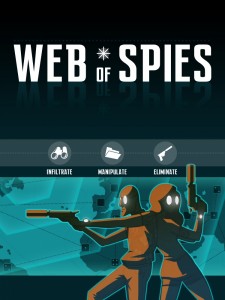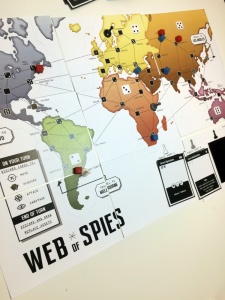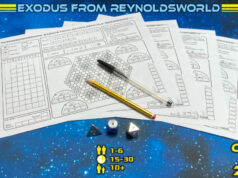Note: This preview uses pre-release components and rules. What you see here may be different from the final, published game.
 From a young age, I have always been intrigued by the world of spies, espionage and intrigue. James Bond has always been a favorite, as well as the novels of Robert Ludlum and John le Carre. It is a genre of fiction that is simultaneously captivating to me, and absent from my board game collection. Web of Spies from designer Cole Medeiros provides players with the opportunity to assemble and control a spy network, and battle for international supremacy with other spy rings looking to challenge for world domination. Does this game allow you to reach your primary objective, or does it leave you in a dark cell, disavowed by your government? Read ahead to find out!
From a young age, I have always been intrigued by the world of spies, espionage and intrigue. James Bond has always been a favorite, as well as the novels of Robert Ludlum and John le Carre. It is a genre of fiction that is simultaneously captivating to me, and absent from my board game collection. Web of Spies from designer Cole Medeiros provides players with the opportunity to assemble and control a spy network, and battle for international supremacy with other spy rings looking to challenge for world domination. Does this game allow you to reach your primary objective, or does it leave you in a dark cell, disavowed by your government? Read ahead to find out!
Web of Spies is a deck-building game for 2-4 players that plays in about an hour. This game plays best with 4 players.
Game Overview
In Web of Spies, you control a ring of five spies who travel around the globe gathering assets and battling other players’ spies. Assets get added to your deck, which grows in size, complexity and power over the course of the game. Depending on the hand you draw on a given turn, you will be able to attack your opponents to take out their spies, or defend your own agents from being eliminated. All actions in the game are predicated on either playing cards (face-up) or discarding cards (face-down). The game ends when one player’s spies are completely eliminated, and the player with the most spies remaining is declared the winner.
How to Play

On the game board, the world map is divided up into 6 regions (corresponding to a face on a white die), with each region containing multiple cities (some of which are labeled to match up a black die). The starting player rolls both the white and black dice to determine the starting city for their five agents, with other players rolling the black die to have their agents start in the same region, but different cities. Three assets are then placed on the board using the same location-dice roll mechanic, with one asset being visible to all players and one “secret asset” played face-down.
Each player starts the game with a standard deck of 7 agent cards (with no inherent powers) and three cards that allow you to attack and defend (a Silenced Pistol, a Forged Identity and a Black Car). At the beginning of each turn, you draw a hand of five cards, which allow you to take your actions for the turn, which are to move, acquire an asset, activate a card’s special power or attack an enemy agent. These actions can be taken multiple times and in any order, provided you have the cards in hand to take them. After all your actions are complete, you discard any cards you did not play and draw a hand of 5 new cards, refreshing your draw deck from your discard pile as needed.
To move your agents across the map, you discard a card (face-down) for every space an agent moves. In order to acquire an asset, your agent needs to be in the city where that asset is located, and you need to discard a number of cards (again, face-down) as noted on the asset card you are acquiring. A special rule is that when you are acquiring the secret asset, the cost is always to discard two cards, no matter what the cost of the secret asset is. Assets can take the form of weapons and tactics (used to attack and defend) or sabotage cards (which allow you to take special actions or react to opponent’s plays). Activating a card’s special power requires you to reveal that card and sometimes remove it from the game in order to have the effect resolve. These can take the form of allowing agents to take a double move, acquire assets for less of a cost or other powerful game effects.
Combat is initiated when two agents are in the same city and the active player plays an Attack card, which contains any number of three different combat symbols. The defending player must follow with a Defense card that matches one of these combat symbols, which can then be countered by another matching Attack card, and so on until one player passes. If the defending player successfully counters all the Attack cards, their agent is safe; if not, their agent is eliminated. The game ends when the one player has all of their agents eliminated, at which point the remaining player who has the most agents wins.

Game Experience
While I would consider this game in the deckbuilding genre, it did not “feel” like a deckbuilder during game play; it used the mechanic without letting the mechanic define the game. In our plays, there were no turns where a player had no actions available to them, which can occur in other titles. When reading through the rules, I had a worry that the game would move slowly due to having to move agents to acquire assets; the thought was that the game would bog down. Quite the opposite – play moved quickly with the assets refreshing at the end of every turn. The fact that there are always options for a player, no matter how poor a draw they received, made game play continually engaging.

Any game that provides the opportunity to create a shared narrative and story to go along with game play is one that is successful in our eyes, and Web of Spies delivers in spades in this regard. For instance, I had Armed Thugs (in this case, I said they were the Triads) snatch up an enemy agent from Hong Kong to London (no doubt through a network established when the British were running Hong Kong) to be interrogated and “disappeared” by MI-5. Being able to string together actions, attacks and defense in the form of a story makes the theme immersive and makes you feel as though you are watching the events in-game transpire in front of you.
While the game plays decently with two players, we found that playing with three or four players is optimal. This is because it is very easy to avoid each other in the early part of the game, and it also allows for negotiation and alliances to be formed over the course of the game. Since the winner is whoever is in the lead when one player is eliminated, it was typical to see that last-place player at times helped out by the other players who were in a position to lose if that player was eliminated. This led to some interesting scenarios as we played.
One of the unique aspects to the game that makes it more exciting is the lack of information for all players. All purchasing and moving is done with discarding cards face-down, which is clever because your opponents cannot deduce what is possibly in your draw deck and hand based on what you have played in previous turns. Also, the secret asset is something that is unknown to your opponents, giving you the element of surprise when you play a card that you added in secret to your deck. This air of mystery contributes both to game play and to enhancing the theme.
Final Thoughts
In its preview form, Web of Spies provided straightforward mechanics and an immersive theme. It is definitely worth checking out if you are into deck building games and the world of espionage and international men (and women) of mystery. Web of Spies functions with two players, but really shines if you can add a third and fourth player.
If you’d like to become a backer, pledges start at $40. It is scheduled to be in the hands of backers in July of 2015 and you have until Friday, Nov 14th to back this project. Check it out here!
As always, we don’t post ratings for preview copies as the components and rules may change from the final game. Check back with us after the game is produced for a full review.






















I’ve played the game three times now and I can easily say this game fills a much-needed niche in my collection. Light deckbuilding, dudes on a map strategy, and lots of take-that action. I love it.
Glad you enjoyed it as much as we did. It fills a niche in terms of theme as well.
Web of Spies has become one of the most popular games in my gaming circles. It has displaced Settlers of Catan as the default game for a weekly session in one group. I’ve been playing the print-and-play version and am eagerly awaiting the published version with the expansion!